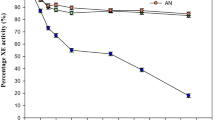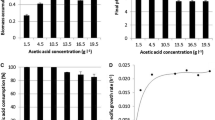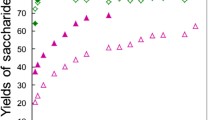Abstract
Cofermentation of xylose and arabinose, in addition to glucose, is critical for complete bioconversion of lignocellulosic biomass, such as agricultural residues and herbaceous energy crops, to ethanol. A factorial design experiment was used to evaluate the cofermentation of glucose, xylose, and arabinose with mixed cultures of two genetically engineeredZymomonas mobilis strains (one ferments xylose and the other arabinose). The pH range studied was 5.0-6.0, and the temperature range was 30-37°C The individual sugar concentrations used were 30 g/L glucose, 30 g/L xylose, and 20 g/L arabinose. The optimal cofermentation conditions obtained by data analysis, using Design Expert software, were pH 5.85 and temperature 31.5°C. The cofermentation process yield at optimal conditions was 72.5% of theoritical maximum. The results showed that neither the arabinose strain nor arabinose affected the performance of the xylose strain; however, both xylose strain and xylose had a significant effect on the performance of the arabinose strain. Although cofermentation of all three sugars is achieved by the mixed cultures, there is a preferential order of sugar utilization. Glucose is used rapidly, then xylose, followed by arabinose.
Similar content being viewed by others
References
Hinman, N. D., Wright, J. D., Hoagland,W. and, Wyman, C. E. (1989),Appl. Biochem. Biotechnol. 20/21, 391–401.
Wright, J. D. (1987), AIChE National Meeting, Minneapolis, MN.
Zhang, M., Franden, M. A., Newman, M., McMillan, J., Finkelstein, M., and Picataggio, S. (1995),Appl. Biochem. Biotechnol. 51/52, 527–536.
McMillan, J. D. and Boynton B. L. (1994)Appl. Biochem. Biotechnol. 45/46, 569–584.
Carlson, T. (1994),Fifth Corn Utilization Conference, June 8–10, St. Louis, MO, National Corn Growers Association.
Doelle, H. W., Kirk, L., Crittenden, R., Toh, H., and Doelle M. B. (1993),Crit Rev in Biotechnol. 13, 57–98.
Ingram, L. O., Eddy, C. K., Mackenzie, K. F., Conway, T., and Alterthum F. (1989),Dev. Indust. Microbiol. 30, 53–69.
Rogers, P. L., Lee, K. J., and Tribe, D. E. (1979),Biotechnol. Lett. 1, 165–170.
Eveleigh, D. E., Stokes, H. W., and Dally, E. L., (1983),Organic Chemicals from Biomass, Wise, D.,ed., Benjamin/Cummings, Menlo Park, CA.
Zhang, M., Eddy, C, Deanda, K. A., Finkelstein, M., and Picataggio, S. (1995),Science 267, 240–243.
Deanda, K. A., Eddy, C, Zhang, M., and Picataggio, S. (1996),Appl. Environ. Microbiol. 62, 4465–4470.
Swings, J. and DeLay, J. (1977), Bacteriol. Rev.41, 1–46.
Author information
Authors and Affiliations
Rights and permissions
About this article
Cite this article
Mohagheghi, A., Evans, K., Finkelstein, M. et al. Cofermentation of glucose, xylose, and arabinose by mixed cultures of two genetically engineeredZymomonas mobilis strains. Appl Biochem Biotechnol 70, 285–299 (1998). https://doi.org/10.1007/BF02920145
Issue Date:
DOI: https://doi.org/10.1007/BF02920145




